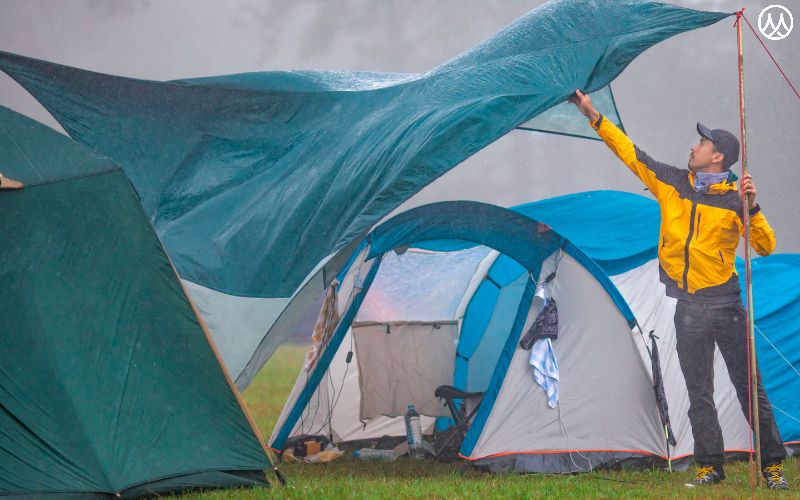In the UAE, where outdoor events, temporary buildings, and outdoor shelterings are commonplace, the right fabric tent may be a life or death. Whether it is a wedding or a construction plant, all over, the one thing in common is the use of fabric-based shelters, but have you ever wondered how they weather the various weather conditions?
Understanding how fabric performs in various climates helps you choose the right material, ensure safety, and make the investment last longer. We are going to see what happens to fabric tents due to heat, humidity, rain, wind, and cold.
High Temperatures and UV Exposure
The Real Challenge in the UAE
The UAE has an extreme amount of sunlight and high temperatures in summer, which can go above 45 °C (113 °F). Under such extreme heat, poor-quality fabric can warp, fade, or even tear. UV rays also break down materials with time, and worse still, when one does not have the right UV protection.
How Fabric Tents React?
Without UV treatment, a typical fabric tent can fade in color and strength in direct sunlight. Fabrics treated with polyester and PVC are more resistant, and however need special coating to withstand a very long UV period.
How to Solve this Problem?
A tent company solution involves the use of high-quality UV-treated fabrics that were specifically made to operate in the desert. Their tent fabric options are made to withstand long hours of sun without losing structural integrity or visual appeal.
Rain and Moisture Resistance
Is Waterproofing Enough?
It is not just the dry picture about the UAE, and rainstorms are possible sometimes, especially in the cooler seasons. Unless your fabric tent is waterproof, you are likely to experience leakages, mould, and internal damage.
Fabric Performance in Wet Conditions
Polyester or PVC-based fabric is naturally water-resistant, but stitching, seams, and zippers can still allow water in if not sealed properly. Canvas is breathable, but it needs to be treated regularly to be waterproof.
How to Ensure Rain Protection
Reputable tent providers offer water-sealed joints, waterproof seams, and coatings. They also have their designs that enable proper runoff to avoid accumulation of water on the roof, which leads to sagging or collapse.
Humidity and Mold Growth
The Invisible Destroyer
The presence of humidity can cause condensation and ultimately mould. This not only damages the tent fabric but also affects the health of occupants.
Fabric Vulnerabilities
Naturally produced fabrics such as cotton canvas are especially susceptible to mould and mildew when not treated. Synthetic materials are also prone to developing problems in case ventilation is inadequate.
How to tackle this problem?
A tent company installs breathable and water-resistant material. Additionally, it ensures proper air circulation through custom ventilation designs and anti-fungal coatings on the tent fabric.
Strong Winds and Sandstorms
The UAE’s Sudden Gusts
Unexpected sandstorms and high winds can rip through poorly anchored tents and shred low-grade fabric.
Fabric Tent Stability
Lighter materials may wave around excessively instead of being stable by making noise and falling apart along their stabilization links. Continuous flapping can leave the seams tattered, and they rip with time.
Cold Weather Performance
Not Just a Summer Solution
Although the climate in the UAE is generally warm, the very low temperatures at night in winter can drop below 10 o C, especially in desert or mountainous regions. It means that you should also have an insulated tent made of fabric.
Fabric Reactions in the Cold
Other materials may be brittle, crack, or shrink when it is cold. Insulation is comfortable, especially when one is sleeping over or relocating to a temporary place.
How to Optimize Cold-Weather Tents
A tent company uses layered tent fabric technology with insulation options that keep interiors warm. They can also be designed to be modular and can also allow the user to add the liners or the heaters where needed.
Choosing the Right Fabric Based on Climate
Not all tent fabric types are created equal. For example:
Polyester: Durable, UV-resistant, light, and it is never heavy. Best Overall.
Canvas: Breathable, but heavy. Requires frequent waterproofing.
PVC-lined fabrics: Maximum water resistance and highest usage.
Al Mawsim Tents has various options of such materials and even assists you in making that decision, depending on location, purpose, and budget.
Why Fabric Tent Quality Matters in the UAE
Due to the harsh and dynamic UAE weather conditions, spending money on the purchase of a cheap and poor quality fabric can lead to expensive recalls, broken of safety, or even downing of the tent.
Being a reliable supplier since the beginning of operations in the region, Al Mawsim Tents considers these risks and provides tailor-made solutions. Their tents are made not only to perform but to be stylish in functionality and long-term consumption.
FAQs:
1. What is the best tent fabric for hot climates?
Tent fabric made from UV-treated polyester or PVC-coated materials is ideal for hot climates like the UAE. Such materials are not susceptible to the sun and stay cool indoors.
2. Can a fabric tent handle sudden rain in Dubai?
When it is provided by a decent manufacturer, whose waterproof fabric tents are sealed at seams and sloped so that the water would run over.
Conclusion
The performance of a fabric tent in the UAE depends greatly on the quality of the fabric and how it’s engineered to face climate challenges. Heat, rain, humidity, and wind have their part to play, but with a good provider, you will not have to worry about them. Al Mawsim Tents has established proficiency in constructing weather-resistant solutions for events, constructions, storage, and others. They include high-performance tents that would shelter you, regardless of the weather forecast.

